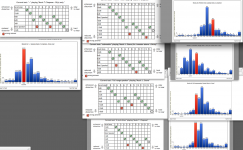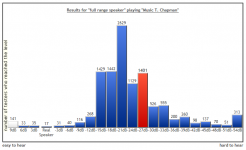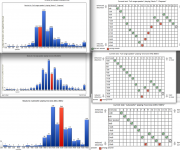Thank you for this Eldam, it is best I hear this from a Frenchman. When I pronounce voilà I use the short 'v' as in viper, short that I have almost finished before I begin to make sound. The harder accent comes down to the 'o' and the 'oi'. In English this sounds like 'wa', but when pronounced well there is a 'v' in front almost like it is a silent 'v'.
At first your words confused me as some European languages pronounce 'w' as if it were almost 'v'. This is unusual in English as I know it.
I can understand it ! It is not funy when a french says: "the" ?
https://www.google.com/#q=integrated+approach+to+damping+marsh&spell=1
while about beam bending it looks like a mostly relevant read - later in the thesis "5-layer" CLD is mentioned
by using a isotropic thick core for the structure and then laminating damping and constraining layers to each surface the structural core "free" surfaces extend/compress and shear the damping layers which respective outer surfaces are constrained by the stiffer and thinner outer layers
with 2 equal isotropic structural layers relative shear would depend on edge conditions - if both are clamped then there is less shear between their inner surfaces - if only one is structural, the other a constraining layer then you are adding way more mass, lowering the resonant frequency and only have one shear layer worth of damping
it really looks like the 5-layer constraint-damping-structural-damping-constraint with thin but stiffer constraining layers on both surfaces of a thick structural plate/beam is a win
Attachments
Last edited:
jcx
I think that the question that I would ask is: "How much more effective, if any, is a multi-layer structure than the simpler three layer?" I have never seen multiple layers used in the marketplace, although I have seen CLD done a lot. Seems like it may have diminishing returns for the expense.
I think that the question that I would ask is: "How much more effective, if any, is a multi-layer structure than the simpler three layer?" I have never seen multiple layers used in the marketplace, although I have seen CLD done a lot. Seems like it may have diminishing returns for the expense.
Very interesting to look at the results, it appears there is a huge difference in listeners ability to perceive different types of distortion evident in the test, although obvious that most listeners could tell when music was distorted.Has anyone taken this test to see where their perception of distortion audibility is?
Listening Test
Although I was able to hear distortion better than average in a few of the tests, tinnitus and noise induced hearing loss at 4kHz has reduced my ability to hear low level detail required to discern distortion.
It is interesting to see that many of the listeners are able to detect distortion as low as 45 dB below the music level, a huge difference from my average of detecting distortion at -10 dB, 32% distortion compared to 1/2%.
Makes me realize my old philosophy of "use well braced void free plywood" is not good enough for everybody who might be listening.
Art
Attachments
weight, structural strength seem to deserve consideration too
I haven't the done the numbers or experiments but if is it as simple as getting the Al foil+polymer damping adhesive layer vibration damping tapes in speaker panel widths - 3M sells some up to 36" wide
if the outer constraining layer needs greater stiffness than heavy foil for full efficiency or just practical dent resistance on the outside then how much expense does <1 mm Al (OK, pricey) or steel (lots cheaper) sheet stock add?
19mm Baltic Birch box with added thin layers CLD inside and out as sketched seems likely to be a reasonable cost/difficulty level for hobbyist speaker construction
I haven't the done the numbers or experiments but if is it as simple as getting the Al foil+polymer damping adhesive layer vibration damping tapes in speaker panel widths - 3M sells some up to 36" wide
if the outer constraining layer needs greater stiffness than heavy foil for full efficiency or just practical dent resistance on the outside then how much expense does <1 mm Al (OK, pricey) or steel (lots cheaper) sheet stock add?
19mm Baltic Birch box with added thin layers CLD inside and out as sketched seems likely to be a reasonable cost/difficulty level for hobbyist speaker construction
Last edited:
Very interesting to look at the results, it appears there is a huge difference in listeners ability to perceive different types of distortion evident in the test, although obvious that most listeners could tell when music was distorted.
Although I was able to hear distortion better than average in a few of the tests, tinnitus and noise induced hearing loss at 4kHz has reduced my ability to hear low level detail required to discern distortion.
It is interesting to see that many of the listeners are able to detect distortion as low as 45 dB below the music level, a huge difference from my average of detecting distortion at -10 dB, 32% distortion compared to 1/2%.
Makes me realize my old philosophy of "use well braced void free plywood" is not good enough for everybody who might be listening.
Art
Thanks for taking the test. I did it with my MDRV6 headphones and a Behringer UCA202. Nothing fancy but I can detect distortion down to -45dB. It may be why I prefer low distortion systems and why the Trynergy sounds so special to me.
Attachments
Participated Klippel Listening Test yesterday few hours before xrk971 did reveal his high sensitivity for distortion and nice score.
Site settings was "full range speaker" "Music T. Chapman" and hardware was Behringer HSP5000 headphones and UMC204HD USB sound device, picture 1.
Today same settings and headphones but via a UCA222 USB sound device tried again, picture 2.
Site settings was "full range speaker" "Music T. Chapman" and hardware was Behringer HSP5000 headphones and UMC204HD USB sound device, picture 1.
Today same settings and headphones but via a UCA222 USB sound device tried again, picture 2.
Attachments
Nice improvement Byrtt. One thing that probably affects our ability besides the gear is our state of mental alertness. I did mine late at night when my mind is sharpest and the house is dead quiet. I hope more people try the test - but the results show that distortion is audible to some more than others even at levels below 1%. Although this topic is tangentially related to the best cabinet material - it may deserve its own thread to keep from going too OT here.
Your Trynergy sounded special to you prior to fixing the buzz/wall flex, suggesting that low distortion is only one aspect of the design that is important.Thanks for taking the test. I did it with my MDRV6 headphones and a Behringer UCA202. Nothing fancy but I can detect distortion down to -45dB. It may be why I prefer low distortion systems and why the Trynergy sounds so special to me.
Program material makes a big difference in distortion perception, changing to Tracy Chapman from T.Jones increased my distortion perception on the full range speaker by 3 dB to -18dB.
Using test tones made a bigger difference, (perhaps because I'm so familiar with tones for identification of speaker and cabinet problems) at -36 (compared to -15 with T.Jones ) on the full range speaker and -30 (compared to -6 with T.Jones).
Art
Attachments
I would like to point out that the Klippel test uses one specific kind of nonlinearity. I could devise a test that would have completely different results - in terms of %, people will always differ. One cannot take the results of the Klippel test and apply them to any other type of nonlinearity.
I should also add that I could always make a speaker that had audible nonlinearity, but that's not the point. The point is that I can always design a speaker that has no audible nonlinearity I prefer to do the later.
I should also add that I could always make a speaker that had audible nonlinearity, but that's not the point. The point is that I can always design a speaker that has no audible nonlinearity I prefer to do the later.
as i can't seem to take the klippel test i'll gladly volunteer to taking any sort of distortion test. can we perhaps host it here?
would be interesting to find out if what i thought was the ability to detect distortion in the countless horns i've heard over the years of doing Pa work is a skill that is irrelevant or in fact really matters.
would be interesting to find out if what i thought was the ability to detect distortion in the countless horns i've heard over the years of doing Pa work is a skill that is irrelevant or in fact really matters.
Last edited:
Your Trynergy sounded special to you prior to fixing the buzz/wall flex, suggesting that low distortion is only one aspect of the design that is important.
Program material makes a big difference in distortion perception, changing to Tracy Chapman from T.Jones increased my distortion perception on the full range speaker by 3 dB to -18dB.
Using test tones made a bigger difference, (perhaps because I'm so familiar with tones for identification of speaker and cabinet problems) at -36 (compared to -15 with T.Jones ) on the full range speaker and -30 (compared to -6 with T.Jones).
Art
Thanks for the update and good to see you have improved audibility of HD with certain stimulus. I did not even realize there was a test tone option. That may make it easier to hear. I just used T Chapman with a full range speaker.
would be interesting to find out if what i thought was the ability to detect distortion in the countless horns i've heard over the years of doing Pa work is a skill that is irrelevant or in fact really matters.
It was precisely this question that led me in my work. I used to assume that distortion was a limiting factor in loudspeaker performance and so I studied the problem. The first thing that I found was that the metrics used for quantifying nonlinear distortion were not accurate, in fact they did not correlate to perception at all. This made them useless as guides to improvement. It is possible to find metric that work well, but no one uses them.
Then while working with a compression driver company we set about to find out what was the cause of the audible issues in a compression driver. This work was published in the AES Journal. It found that nonlinear distortion was not a significant factor in a compression drivers perception although frequency response was.
But still, horns do sound bad at higher levels so if it was not the compression driver then what was it. Upon further investigation into the perception of horns, I found that there are Higher Order Modes in them that while they are linear, they have a nonlinear perception - i.e. they become more audible with higher SPLs. This makes them sound like HD, but yet it isn't. Horn are linear devices, but can sound nonlinear.
That's where things stand today in my book.
Klippel's test is contrived to show nonlinearity in its worst case (inductance nonlinearity). These results cannot be inferred to mean that the same level of distortion would be audible in another form. It must also be noted that if loudspeaker nonlinearity is not audible - and clearly it can be made so - then he is out of business. He has every reason to show nonlinearity as audible and it is in some badly designed drivers.
i am familiar with the paper "Subjective Testing of Compression Drivers" is that the one you are referencing?
to ensure i understand correctly HOM's are congruent to linear distortion?
and as i'm still learning about horn design myself i can't say i entirely agree with the statement that horns are linear devices, most i've encountered have a rising response with an increase in frequency. when jbl first introduced the flat faced constant directivity horns (sorry i will get specific model numbers and submit them) they where not well received by end users until a compensation network was implemented to correct the issue. that does correlate to your findings of favoring flat frequency response over distortion but i'm confused as to how you view horns as linear. i hope your explanation is not going to confound my limited understanding further...
to ensure i understand correctly HOM's are congruent to linear distortion?
and as i'm still learning about horn design myself i can't say i entirely agree with the statement that horns are linear devices, most i've encountered have a rising response with an increase in frequency. when jbl first introduced the flat faced constant directivity horns (sorry i will get specific model numbers and submit them) they where not well received by end users until a compensation network was implemented to correct the issue. that does correlate to your findings of favoring flat frequency response over distortion but i'm confused as to how you view horns as linear. i hope your explanation is not going to confound my limited understanding further...
Earl,Then while working with a compression driver company we set about to find out what was the cause of the audible issues in a compression driver. This work was published in the AES Journal. It found that nonlinear distortion was not a significant factor in a compression drivers perception although frequency response was.
Klippel's test is contrived to show nonlinearity in its worst case (inductance nonlinearity). These results cannot be inferred to mean that the same level of distortion would be audible in another form. It must also be noted that if loudspeaker nonlinearity is not audible - and clearly it can be made so - then he is out of business. He has every reason to show nonlinearity as audible and it is in some badly designed drivers.
The Klippel Listening test does not show show nonlinearity only in its "worst case", it compares the multiple interactions at various levels allowing anyone to determine their own ability to hear those various distortions at a progressively diminished contribution to the signal.
The Klippel Listening test includes more than four nonlinearities in the electro-mechanical system that produce distortion:
Bl(x): The variation of the Force Factor with displacement
CMS(x): The variation of suspension Compliance with displacement
LE(x): The variation of voice coil Inductance with displacement
The model also includes additional effects, such as Para-Inductance, thermal power compression, jump out effect of the voice coil, nonlinear compression of the amplitude, and the complex interaction between the different nonlinearities.
As far as your study, it did not prove (or disprove) that nonlinear distortion was not a significant factor in a compression drivers perception, as your test's voltage levels covered only a 6 dB range, resulting in high levels of distortion (5-10% at 1000 Hz ranging up to 10-35% in the 4-9 kHz range) and did not compare those distorted drivers output to the reference recording, so your continued assertion that "THD in a compression driver is not audible" continues to be an unfounded conclusion.
The fact that you don't believe HD matters does not change the fact your test did not prove what you continue to claim.
I still agree completely with your observation:
"In hindsight it is apparent that the addition of a dummy source, one that was in fact the reference, would have added value to the interpretation of the results. It is most unfortunate that this possibility was not seen beforehand."
http://www.diyaudio.com/forums/multi-way/103872-geddes-waveguides-661.html
And it is most unfortunate that you yourself seem to have never bothered to listen to another test that does allow comparisons of a wide range of distortion in multiple drivers to the reference recording.
Perhaps you wouldn't want objectivity to stand in the way of your repeating past conclusions based on a flawed test ;^).
Cheers,
Art
Attachments
- Home
- Loudspeakers
- Multi-Way
- The best cabinet material !!!!








